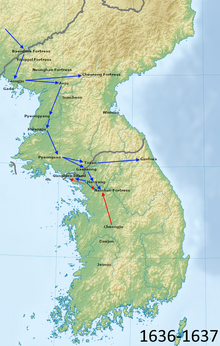
Back غزو المانشو الثاني لكوريا Arabic Invasió Qing de Joseon Catalan داگیرکاری چینگ بۆسەر جۆسۆن CKB Invasión Qing de Joseon Spanish تهاجم چینگ به چوسان Persian Seconde invasion mandchoue de la Corée French Invasi Joseon oleh Qing ID Seconda invasione manciù della Corea Italian 丙子の乱 Japanese 병자호란 Korean
| Qing invasion of Joseon | |||||||
|---|---|---|---|---|---|---|---|
| Part of Korean–Jurchen conflicts, Ming-Qing transition | |||||||
 | |||||||
| |||||||
| Belligerents | |||||||
| Qing dynasty |
Joseon dynasty Ming dynasty | ||||||
| Commanders and leaders | |||||||
|
Hong Taiji Dorgon Ajige Dodo Hooge Oboi Kong Youde Geng Zhongming Shang Kexi |
King Injo Im Gyeong-eop Hong Myeong-gu Yu Lim | ||||||
| Strength | |||||||
| 100,000[1] | 80,000–90,000[citation needed] | ||||||
| Casualties and losses | |||||||
| Unknown | Unknown | ||||||
| Korean name | |
| Hangul | 병자호란 |
|---|---|
| Hanja | |
| Revised Romanization | Byeongja Horan |
| McCune–Reischauer | Pyŏngcha Horan |
The Qing invasion of Joseon (Korean: 병자호란; Hanja: 丙子胡亂) occurred in the winter of 1636 when the newly established Qing dynasty invaded the Joseon dynasty, establishing the former's status as the hegemon in the Imperial Chinese Tributary System and formally severing Joseon's relationship with the Ming dynasty. The invasion was preceded by the Later Jin invasion of Joseon in 1627.
The invasion resulted in a Qing victory. Joseon was forced to establish a tributary relationship with the Qing Empire, as well as cut ties with the declining Ming. The crown prince of Joseon along with his younger brother were taken as hostages, but they came back to Joseon after a few years. One of the two later became the King Hyojong. He is best known for his plan for an expedition to the Qing Empire.